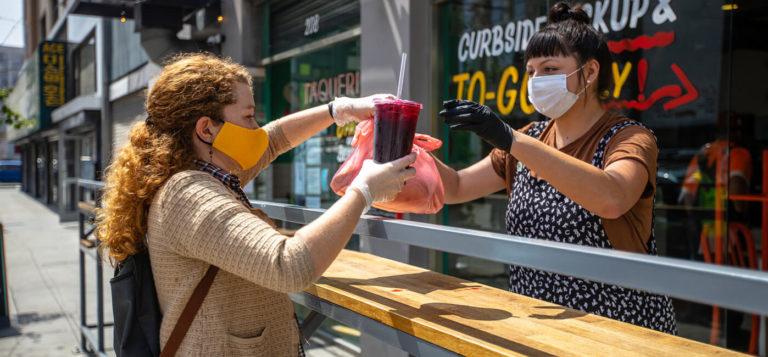At first glance, it might be hard to see the link between out-of-home (OOH) advertising and mobile. One is static, while the other’s always moving. One has been around for hundreds of years, while the other is a modern invention.
When you think about it, though, these two marketing channels have a lot in common. Both leverage location to reach the right audience. Whether an ad takes the form of a billboard on a busy commuter highway or appears on a treadmill at the gym, OOH advertisers target consumers based on where they go and when, while mobile campaigns rely on foot traffic intelligence and location data to do the same.
In a way, out-of-home is the original location-based ad. And that makes mobile the perfect match for OOH campaigns.
Out-of-Home is Top of Mind for Brands
In 2016, OOH was the only traditional media category other than TV to see an increase in ad spending, according to eMarketer. As The New York Times reported last fall, billboard companies are “not only surviving — they’re flourishing,” with ad spending rising for 24 quarters straight.
The ongoing growth of OOH media is impossible to ignore. Active lifestyle marketing company Zoom Media now reaches consumers in 3,000 health clubs with digital signage in 160 markets across the US, while Captivate’s lobby and elevator ads reach upwards of 10 million business professionals each month. Why the boom? Marketers recognize the value of this form of location-based advertising and the impact it stands to have on brand awareness and reach, and that’s creating what MediaPost has referred to as an OOH advertising renaissance. Unlike the campaigns of old, though, OOH is now has a powerful ally: mobile.
Why Pairing OOH and Mobile is a Marketing Must
For a long time, mobile was perceived as a newfangled approach to marketing and the stuff of early adopters. Not so anymore. As we move from early to late majority adoption, brands can no longer overlook the importance of this technology and where it fits into their overall marketing plan.
EMarketer recently reported that mobile will represent 84 percent of digital ad spending in the US by the year 2021 compared with 16 percent for desktop, while spending on mobile ads is expected to grow by more than 34 percent this year.
Evolving consumer behavior plays a big part in the mobile and OOH marketing explosion. As the Times points out, consumers are spending more time out of the house, “partly because of an increase in travel and commuting and also because smartphones keep them connected when they are away from home or work.” The more time consumers spend with their mobile devices out in the world, the more they’re exposed to both mobile and OOH ads, and the greater the marketing opportunity becomes.
So how can brands maximize these highly compatible channels? With mobile marketing, and location-based ads in particular, we’re able to understand who a customer is, where they’ve been, and what they’re likely to do next. Marketers can even influence this last event by leveraging foot traffic trends to deliver a more personalized and relevant ad experience.
Imagine the potential of these ads when paired with OOH. We already use mobile to determine which locations are a good fit for our target audience — fast food chains, for example, can select which customers to target based on a combination of their proximity to a store location and the interests and needs demonstrated by their previous behavior. But OOH advertisers can also use mobile to inform them on the value of potential advertising locations by determining whether there are enough “fast food visitors” in the vicinity to justify a billboard. According to the Outdoor Advertising Association of American (OAAA), “With the help of smartphones…OOH can intercept consumers who are near or at the point of purchase like no other ad medium.”
Mobile also has the ability to provide insight into other aspects of OOH strategy, like where potential customers are coming from, and how your ad placements influence their purchasing decisions. When you know that a large volume of visitors around your billboard are, say, from affluent neighborhoods, you’re better able to create messaging that will resonate with them.
Mobile and Your Presence at Key Moments of Intent
The modern consumer can be described in two ways: on-the-go, and connected. Amazingly, Cisco reports that by the year 2021 more people worldwide will have a mobile phone than a bank account, running water, or a landline. As a result, consumers will rely more and more on their mobile devices, using them to navigate their world as well as fill it with what they need. Just consider last year’s Cyber Monday activities. In 2016, American spent $205 million shopping on their smartphones, and mobile’s share of Cyber Monday shopping is growing with each passing year.
All of this makes mobile a valuable marketing tool for measuring purchasing behavior and intent related to OOH campaigns, and the key to unlocking the mindset of the consumers cross-channel marketers hope to reach. Remember, what consumers tell brands and what they actually do isn’t always consistent. That makes foot traffic data vital to following their movements in order to better meet their needs.
Out-of-home advertising may be thriving, but marketers are only just beginning to explore the role that mobile can play in creating more effective and efficient campaigns. Together, OOH and mobile are capable of taking location-based advertising to a whole new level.






